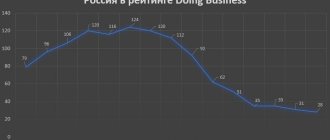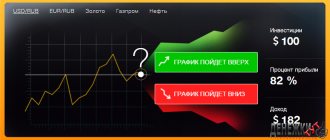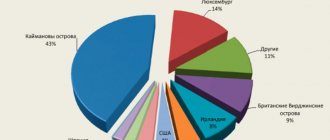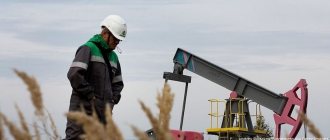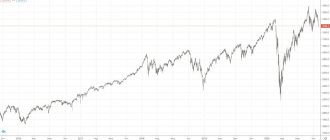01/22/2015 20 472 24 Reading time: 27 min. Rating:
Author
: Konstantin Bely
Welcome to Financial Genius! Today I will try to clearly explain to you what gold and foreign exchange reserves (gold reserves) are, what they should be, what happens when gold reserves rise or fall, is this good or bad, etc. Recently, many media outlets have often speculated on information about a decrease in the gold and foreign exchange reserves of Russia or Ukraine, presenting this as something extremely negative, for example, as an approach to default. Is the decline in gold and foreign currency reserves really that scary, and what does this mean for the country’s economy? All this is discussed in today’s article.
Concept
The state's gold and foreign exchange reserves are highly liquid assets that are under the control and management of the main executive body responsible for credit and financial regulation.
The balance sheet of the Central Bank of the Russian Federation is formed by assets and liabilities. The first group includes cash and other financial instruments. The second contains obligations. The balance must be in balance. This is an axiom.
When issued, the money that appears must be backed by something. Gold and foreign exchange reserves are also designed to solve this problem. Gold and foreign currency reserves are the most reliable and liquid way to secure money issued in the country. However, this is not the only task that the Central Bank’s gold and foreign exchange reserves solve.
Why are they needed?
The purpose of the financial instrument in question is encrypted in its name. Gold and foreign exchange reserves represent an autonomous monetary fund - the country's reserve. Gold and foreign exchange funds are used in the event of an unforeseen, often crisis, situation. This is the same stash for a rainy day only on a state scale.
As the practice and actions of the Central Bank of the Russian Federation show, gold and foreign exchange reserves are spent on solving the following problems:
- maintaining a stable exchange rate of the national currency;
- financial assistance or lending to other states;
- the need to cover the country's balance of payments deficit.
Simply put, gold and foreign currency reserves are responsible for the stable position of the Russian financial system.
What parts do they consist of?
The state's gold and foreign exchange reserves have a fairly simple structure. They consist of four parts:
- gold in bars and coins;
- funds in foreign currency;
- depositary receipts or SDRs;
- reserve position or voting share in the IMF.
You need to understand that the listed sources from which the gold and foreign currency reserves of the Central Bank of the Russian Federation are formed are not the same both in size and in value.
For Russia, the main elements of the above structure are gold and foreign currency. They account for the lion's share of existing gold and foreign exchange reserves.
Cash denominated in foreign currencies is also heterogeneous. In this capacity are:
- cash;
- account balances;
- deposits in foreign banks;
- securities.
Monetary gold is considered an integral part of gold and foreign exchange reserves. Special premises are equipped for storing 995 fine bars and coins. This is Russia's gold reserve.
Where are foreign exchange reserves stored?
The owner of gold and foreign currency reserves is the state. Gokhran is in charge of storing gold reserves in Russia. The fund houses gold as a universal precious metal, as well as platinum and platinum group metals: palladium, rhodium, ruthenium, osmium. In addition, Gokhran stores rough diamonds, emeralds, rubies, and sapphires. Part of the gold and currency reserves is located in the Central Repository of the Central Bank of the Russian Federation. Another part of the gold and currency reserves is stored in securities that are distributed across several countries. In recent years, Russia has begun to reduce purchases of American securities, giving preference to European ones. According to the US Treasury, Russian investments in American securities in January of this year amounted to $13.18 billion, which is $36 million less than in December 2018.
Current status
The policy of the Central Bank of the Russian Federation regarding gold and foreign exchange reserves is distinguished by a balanced and systematic approach. In the absence of a crisis, the regulator seeks to increase this financial reserve of the country.
As of February 15, 2021, the size of gold reserves amounted to 447.4 billion US dollars.
The Central Bank of Russia weekly updates information on the state of the country's gold and foreign exchange reserves. To obtain up-to-date information, you must go to the official website of the regulator.
The structure of Russia's gold and foreign currency reserves is as follows:
- securities – 77%;
- cash currency and deposits – 10%;
- monetary gold – 10%;
- SDR – 2%;
- position in the IMF – 1%.
In what cases will gold reserves be used?
The wealth of a country is judged by the amount of gold reserves. Gold is not used directly in calculations. It is needed for an emergency purchase of currency or obtaining a secured loan. Of all gold and currency reserves, currencies and securities are most often used. Gold is simply accumulated in vaults and serves as a guarantee of state stability. Gold will be used only in an emergency when there is no access to other reserves, or it will be very unprofitable to use them. The role of the gold reserve remains unchanged. It consists of leading the country out of crisis and saving the state and citizens in emergency situations.
Author of the article, financial expert
Dmitry Tachkov
Hello, I am the author of this article. I have a higher education. Specialist in finance and banking. Worked in commercial banks of the Russian Federation for more than 3 years. I have been writing about finance for more than 5 years. Always on topic about the best deposits and cards. I make profitable deposits and receive high cashback on cards. Please rate my article, this will help improve it.
about the author
Useless
3
Interesting
8
Helped
6
Who controls
There are three approaches or models for managing the state’s gold and foreign exchange reserves.
- The owner and manager of gold and foreign currency reserves is the Central Bank of the state. The regulator resolves all issues related to this reserve. In such a model, only the Central Bank can increase or decrease gold and foreign exchange reserves, as well as determine their structure. France and Germany have implemented a similar approach.
- The owner and manager of gold and currency reserves is the Ministry of Finance or the State Treasury. All key decisions are made by these bodies. With this approach, the Central Bank is responsible only for performing technical functions. The UK has implemented a similar model.
- Mixed approach. In this model, the powers to form and manage the country's gold and foreign exchange reserves are divided between the Central Bank and the Ministry of Finance or the Treasury. This approach was implemented by Russia, Japan, and the United States of America.
Monetary gold
The term "monetary gold" refers to the yellow metal in the form of bars or coins. In the Russian Federation it is stored in Gokhran.
The amount of gold stored is constantly changing. For example, in 1953 the mass was 2050 tons, which is a record. By 1991, the stock stood at 484 tons.
At the beginning of 2021, Russia's gold and foreign exchange reserves amounted to 2,271 tons.
Countries with the largest volume of gold in gold reserves (from Wikipedia at the beginning of 2020):
- USA – 8133;
- Germany – 3366;
- Italy – 2451;
- France – 2436;
- Russia – 2271;
- China - 1948;
- Switzerland – 1040;
- Japan – 765;
- India – 625;
- Netherlands – 612;
As a percentage by the share of gold in gold and foreign currency reserves as a percentage (from Wikipedia at the beginning of 2020):
- USA – 76.6;
- Portugal – 76.4;
- Germany – 72.8;
- Netherlands – 68.7;
- Tajikistan – 68.1;
- Italy – 68.0;
- Greece – 66.3;
- Cyprus – 64.7;
- Kazakhstan – 62.5;
- France – 62.4;
- Russia – 19.9;
In addition to gold, the Central Bank can purchase small shares of other valuable metals: palladium, platinum, silver, diamonds.
- How to buy gold for an individual - detailed description;
- Protective assets for ordinary investors;
How are they managed?
Financial elites within the state often debate about the correct methods of managing gold and foreign exchange reserves. The subject of the dispute is simple: should gold and foreign exchange reserves be used to generate additional income in favor of the state.
On the one hand, the task of such a financial reserve is to guarantee the availability of funds in the event of a crisis situation. On the other hand, some economists believe that money should not lie idle. They should be invested, and the profits received should be sent to the state budget.
There is a sound grain in the reasoning of supporters of each of the two approaches.
In most countries, central banks take a conservative position and follow the path of minimizing risks. The Russian Central Bank is no exception to this rule.
The regulator places funds from gold and foreign exchange reserves exclusively in highly reliable instruments for which there are government guarantees. This approach brings less income, but guarantees better liquidity and safety of invested money.
The Bank of Russia minimizes existing risks. When placing gold and foreign exchange reserves, the principle of diversification is used. For example, money is invested immediately in a number of freely convertible currencies. They are placed in US dollars, pounds sterling, euros, Swiss francs, Chinese yuan and Japanese yen.
When choosing securities for investment, the Central Bank of the Russian Federation uses credit ratings of issuer reliability from the world's leading rating agencies.
Why was gold chosen to form reserves?
Gold has long been a means of equal payment between countries and peoples. If a currency has value only in the territory of one state, then everyone is ready to exchange for gold.
Gold is a universal medium of exchange that has value for any party. With its help trade took place all over the world. After gold coins were withdrawn from circulation, banknotes took their place. Then countries started thinking about a gold reserve to back up the value of paper money. And now gold serves as a guarantee for all international payments, as well as a safety net in an economic crisis.
Change of size
The country's gold and foreign exchange reserves are a dynamic value. Depending on the current macroeconomic situation, the Central Bank actively manages this additional reserve. Gold reserves can either increase or decrease. Each such change leads to an adjustment of the economic situation in the state.
An increase or decrease in foreign exchange reserves does not necessarily reflect the stability or level of economic development. Often such changes show what monetary policy is being pursued by the Central Bank.
Many prominent financial experts and analysts express the idea that the constant increase in the volume of gold and foreign currency reserves should not become an end in itself for the Central Bank. There should not be a goal to make the financial reserve as large as possible.
Otherwise, the state will face the problem of irrational use of funds. The budget will receive less profit from unmade investments.
Thus, one of the main tasks of the Central Bank is to ensure a sufficient, but not excessive level of gold and foreign exchange reserves.
Level of international reserves
International reserves of the world's countries in 2006
| States with the largest international reserves. | China | 3316 (December 2011) |
| 2 | Japan | 1063 (December 2011) |
| – | Eurozone | 886,355 (July 2011) |
| 3 | Saudi Arabia | 556.2 (December 2011) |
| 4 | Russia | 513.0 (December 2011) |
| 4 | Republic of China (Taiwan) | 418.4 (December 2011) |
| 5 | Brazil | 357.9 (December 2011) |
| 6 | India | 345.8 (December 2011) |
| 7 | The Republic of Korea | 320.1 (December 2011) |
| 8 | Hong Kong | 288.8 (December 2011) |
| 9 | Switzerland | 270.3 (December 2011) |
| 10 | Singapore | 248.7 (December 2011) |
Notes:
- ^China updates information quarterly.
- ^Russia and India update information weekly and monthly.
- ^Brazil updates information daily.
These countries hold more than 50% of the world's total international reserves.
Adequacy
A number of methods have been developed to allow Central Bank specialists to determine the level of gold and foreign currency reserves required in the current economic situation.
Many developed countries in the world assess the adequacy of financial reserves based on the volume of imports. When using this criterion, the minimum required amount of gold and foreign exchange reserves must be equal to the total volume of imports of the country for three months.
According to another method, the size of gold reserves is tied to the gross domestic product (GDP). The inventory level should not be lower than 9% of the specified indicator.
Taking into account the current size of Russia's gold and foreign exchange reserves of 447.4 billion US dollars, we can say that its actual value exceeds the recommendations of foreign financiers. Moreover, the Central Bank of the Russian Federation continues to increase the size of gold and foreign currency reserves.
In connection with this, we can conclude that the Central Bank, in a difficult political situation, decided to play it safe and is increasing the financial cushion, which is already sufficient today.
How will an increase in gold and foreign exchange reserves affect Russians?
According to analyst and financial market expert Dmitry Golubovsky , an increase in gold and foreign exchange reserves is a positive factor for restoring Russia's credit rating and ensuring the stability of the ruble. In addition, according to the expert, if new sanctions are introduced against Russia, their effect will be limited due to the fact that gold reserves will be sufficient to neutralize such a blow.
“The margin of safety has been restored to the pre-sanction level, this is good for financial stability, and also for the credit rating. Today's record is that the gold and foreign exchange reserves now cover the entire external debt of the country. In other words, if they refuse us a loan at all and demand that we pay back all the money we owe, then we will pay off. Accordingly, the fear of sanctions is greatly exaggerated. Even if the United States introduces something very tough, there won’t be any catastrophe; we’ll pay off our debts,” says Golubovsky.
Article on the topic Is there a crisis on the horizon? Why does Russia buy gold in large quantities?
Part of Russia's gold and foreign currency reserves in the USA
As of the beginning of 2021, $109 billion of our country's total gold and foreign exchange reserves are held in debt obligations of the United States of America.
Many prominent domestic economists (M. Delyagin, A. Razuvaev) say that this is a serious mistake on the part of the financial block of the Russian Government.
The risks of such investments are associated with the fact that the US national debt is increasing every year. American budget expenditures significantly exceed revenues. The situation under consideration looks like a standard financial pyramid. At a critical moment, Americans may simply refuse to pay their bills. This already happened during the default in 1971.
At the same time, the Central Bank of the Russian Federation is not making any attempts to return the gold and foreign exchange reserves back to our country. One gets the impression that leading domestic financiers are satisfied with this situation.
It should be noted that the Russian Federation is not a leader in purchasing US debt. For example, our country lags behind China and India in this matter by more than 10 times.
There is also an alternative opinion. A number of economists (N. Krichevsky) consider this problem to be largely far-fetched. They say that the Central Bank of the Russian Federation correctly chose American instruments to store part of its gold and foreign exchange reserves.
Structure of world foreign exchange reserves
International savings in foreign exchange reserves
| 1995 | 1996 | 1997 | 1998 | 1999 | 2000 | 2001 | 2002 | 2003 | 2004 | 2005 | 2006 | 2007 | 2008 | 2009 | 2010 | 2011 | 2012 | 2013 | 2014 | |
| USD | 59,0 % | 62,1 % | 65,2 % | 69,3 % | 70,9 % | 70,5 % | 70,7 % | 66,5 % | 65,8 % | 65,9 % | 66,4 % | 65,7 % | 64,1 % | 64,1 % | 62,1 % | 61,8 % | 62,3 % | 61,1 % | 61,0 % | 63,1 % |
| EUR | 17,9 % | 18,8 % | 19,8 % | 24,2 % | 25,3 % | 24,9 % | 24,3 % | 25,2 % | 26,3 % | 26,4 % | 27,6 % | 26,0 % | 24,7 % | 24,3 % | 24,4 % | 22,1 % | ||||
| DEM | 15,8 % | 14,7 % | 14,5 % | 13,8 % | ||||||||||||||||
| GBP | 2,1 % | 2,7 % | 2,6 % | 2,7 % | 2,9 % | 2,8 % | 2,7 % | 2,9 % | 2,6 % | 3,3 % | 3,6 % | 4,2 % | 4,7 % | 4,0 % | 4,3 % | 3,9 % | 3,8 % | 4,0 % | 4,0 % | 3,8 % |
| JPY | 6,8 % | 6,7 % | 5,8 % | 6,2 % | 6,4 % | 6,3 % | 5,2 % | 4,5 % | 4,1 % | 3,9 % | 3,7 % | 3,2 % | 2,9 % | 3,1 % | 2,9 % | 3,7 % | 3,6 % | 4,1 % | 3,8 % | 3,9 % |
| FRF | 2,4 % | 1,8 % | 1,4 % | 1,6 % | ||||||||||||||||
| CHF | 0,3 % | 0,2 % | 0,4 % | 0,3 % | 0,2 % | 0,3 % | 0,3 % | 0,4 % | 0,2 % | 0,2 % | 0,1 % | 0,2 % | 0,2 % | 0,1 % | 0,1 % | 0,1 % | 0,1 % | 0,3 % | 0,3 % | 0,3 % |
| Others | 13,6 % | 11,7 % | 10,2 % | 6,1 % | 1,6 % | 1,4 % | 1,2 % | 1,4 % | 1,9 % | 1,8 % | 1,9 % | 1,5 % | 1,8 % | 2,2 % | 3,1 % | 4,4 % | 5,1 % | 6,3 % | 6,5 % | 6,9 % |

